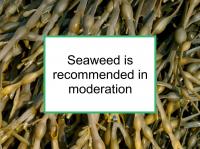Seaweed refers to edible seaweed or macroalgae such as dulse, kelp (including arame and wakame), nori, and sea lettuce (Ulva lactuca) and various Monostroma. Edible algae are also included in this webpage. Generally speaking, seaweed is a good dietary source of calcium, iodine, and fiber.
Some seaweed varieties are also good sources of vitamin A, vitamin B12, vitamin C, vitamin E, vitamin K, manganese, magnesium, selenium, copper, or zinc. In addition, seaweed can be a rich source of carotenoids. For example, brown seaweeds contain beta-carotene, fucoxanthin, and violaxanthin. Some algae are a source of astaxanthin. In addition, seaweed contains some unique compounds, such as various fucoidans (found in brown seaweeds), stearidonic acid (brown seaweeds), phlorotannins (kelp), mycosporine-like amino acids and phenolic acid (dulse), all of which have been shown to have anticancer properties in the laboratory.
Breast cancer-related effects of consuming seaweed
Evidence that seaweed consumption could reduce breast cancer risk is based primarily, but not exclusively, on studies of brown seaweeds:
- Consumption of brown seaweeds has been shown to favorably alter estrogen metabolism in women. Extract of common kelp has been reported to inhibit the binding of estradiol to estrogen receptors and progesterone to the progesterone receptor. Bladderwrack (another type of edible kelp) has also been reported to exert anti-estrogenic effects in pre-menopausal women
- Specific unique components (fucoidan, fucoxanthin, alginic acid, laminarin) of brown seaweeds have been shown to inhibit cancer proliferation, including triple negative (ER-/PR-/HER2-) cell proliferation. However, red seaweeds, which lack these compounds, also inhibit proliferation, suggesting that other seaweed compounds may be important
- Seaweed appears to enhance intestinal conversion of phytoestrogens, for example, the production of equol from daidzein. This could explain some of the breast cancer protective effects of dietary seaweed and soy in Asian populations with high consumption of both
- The brown seaweed wakame (a type of kelp) has been shown to contain the omega-3 fats eicosapentaenoic acid and stearidonic acid, which may contribute to reduced breast cancer risk. Some other types of seaweed have been reported to contain docosahexaenoic acid, another marine omega-3 fat. Wakame was found to reduce breast cancer proliferation in rats in one Japanese study. In addition, wakame extract has been shown to induce cell death in human hormone receptor negative (ER-/PR-) breast cancer cells and to suppress mammary carcinogenesis in rats when administered in daily drinking water
- Various types of red, brown and green algae have been found to be good sources of melatonin. Melatonin protects against breast cancer in several ways, including by reducing aromatase activity within the breast, thereby decreasing estrogen production
- The relatively high iodine content of seaweed may contribute to reduced breast cancer risk (but could be a concern for those with thyroid disorders)
- The relatively high levels of calcium found in seaweed are also thought to contribute to seaweed's chemopreventive effects, in combination with its other components.
Additional comments
Most seaweed is dried after being harvested and must be rehydrated before use. Nori is a common seaweed ingredient in sushi. Currently, in the U.S., seaweeds are used mainly as a source of gums, gelling compounds and thickeners (such as agar) for use in foods such as ice cream, and some industrial applications.
Seaweed readily incorporates minerals from the surrounding water — minerals can account for more than one-third of seaweed dry matter. While this can make some seaweeds a rich source of beneficial micronutrients, it can also make them a dietary source of heavy metals, including arsenic. One analysis of dried seaweed samples purchased in London and over the Internet found that some contained unacceptable levels of arsenic. Purchasing seaweed that is tested for heavy metals and other contaminants makes sense.
Several types of freshwater microalgae, including spirulina and other types of blue-green algae, have been marketed as supplements in the U.S. since the early 1980s. Blue-green algae contains phycocyanin and alpha-linolenic acid, both of which have been shown to have chemopreventive activities. However, such freshwater algae can also contain concentrated amounts of heavy metals, as well as toxic microcystins, depending on where it is grown.
Whether or not they contain heavy metals, many microalgaes are not edible. In fact, they may be harmful if consumed, and there have been instances of microalgae supplements sold that turned out to be toxic. Therefore, consumers of such supplements should assure themselves of the reputability of the manufacturer.
Seaweed supplements are not recommended
We suggest consuming seaweed as food rather than taking fucoidan or fucoxanthin supplements since (1) as outlined above, a variety of seaweed components may also contribute to seaweed's anti-carcinogenic effects; (2) the compounds, minerals and fiber found in seaweed may act synergistically to reduce cancer risk; and (3) safe and effective levels of these supplements have not been established.
Since seaweeds have varying amounts of iodine and other nutrients, it can be difficult to know how much is in any given seaweed supplement. People with thyroid disorders may find that their conditions are made worse by eating kelp or taking seaweed supplements. High intake of iodine may result in elevated blood pressure and blood sugar. Some seaweeds also incorporate substantial levels of sodium, which can also worsen high blood pressure for those susceptible.
Sources of information provided in this webpage
The information above, which is updated continually as new research becomes available, has been developed based solely on the results of academic studies. Clicking on any of the underlined terms will take you to its tag or webpage, which contain more extensive information.
Below are links to 20 recent studies concerning seaweed and its components. For a more complete list, including less recent studies, please click on seaweed.
